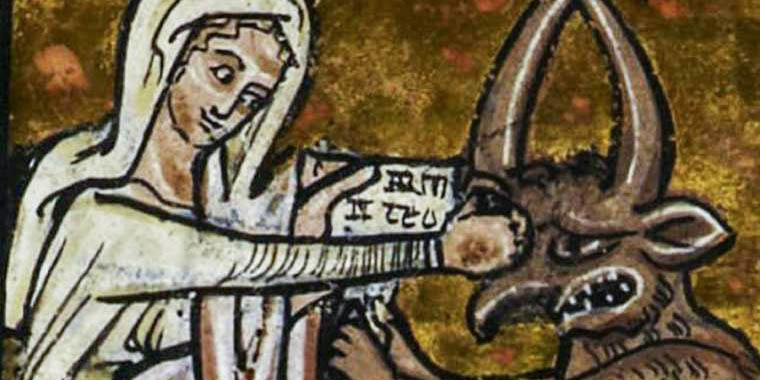By Emily Stimpson Chapman
Emily Stimpson Chapman is an award-winning Catholic author of over a half-dozen books, including Hope to Die: The Christian Meaning of Death and the Resurrection of the Body, co-authored with Scott Hahn; The Catholic Table: Finding Joy Where Food and Faith Meet; These Beautiful Bones: An Everyday Theology of the Body; and The Catholic Girl’s Survival Guide for the Single Years. She also is the editor of the high school faith formation series Formed in Christ and the author of numerous studies for the women’s ministry Endow. Chapman lives in Pittsburgh with her husband, Chris, and their three young children.

Dear Emily,
I wasn’t going to write this morning, as Toby’s godparents and their four girls are still here with us, and we have a day full of plans. I didn’t want to close out this particular series of letters, however, without a word about the Blessed Mother.
I know, even now, after your return to the Church, Mary remains a sticking point for you. Your struggle isn’t intellectual. You accept the four Marian dogmas. You believe Jesus redeemed His mother at the moment of her conception, that God, who exists outside of time, applied the graces of Calvary to her at the first second of her existence, making Mary “full of grace” from the start. You agree that she should be called the Mother of God. She is the mother of Jesus, after all, and Jesus is God, one of the three Divine Persons of the Trinity. There isn’t a human Jesus and a Divine Jesus. There is one Jesus. She is His mother.
You also accept Mary’s Perpetual Virginity, although you do that more on faith at this point. After you read John Paul II’s Theology of the Body, however, you’ll grasp this dogma with your reason, too. Once you understand that “the body expresses the person,” it makes sense to you that Mary’s body should perfectly express who she was, a woman fully consecrated to God, completely the Lord’s own. As for the Assumption, we all will be resurrected one day, in body and soul. These fragile, fragmented bodies of ours will be made whole. Like Christ’s own body, they will be transfigured. So, you understand why Mary, the archetype of humanity, gets to enjoy that grace from the first.
If you and I were sitting together now, you could explain all these dogmas to me almost as well as I just explained them to you. You’ve read about what the Church teaches, and you accept what the Church teaches. Your head is fine with Mary. It’s your heart that struggles. You struggle with her—with who she is . . . or, more accurately, with who you think she is. You know she is supposed to be your mother, model, and guide. You’re already praying your Rosary daily. But then you walk into a church and see a statue of her, looking so gentle, meek, and mild, and think, “There’s no way I can be like her.”
Let’s be honest. You also think, “I don’t want to be like her.” You think being meek and mild means being weak and saccharine sweet. And you know, if you try to your dying day, you will never be that. Mary could model sweetness till the cows come home, but you’re still going to be pure redheaded salt. With which you are fine. You prefer it that way. Salt keeps things interesting.
The problem with your normally excellent reasoning, Emily, is that you’re looking at Mary as a creature of plaster and paint, not flesh and blood. You’re seeing the statue, not the woman.
You won’t discover this flaw in your thinking until 2004, when you and a friend head to the theater to see The Passion of the Christ. On the screen, you don’t see a statue of a girl. Instead, you see a woman, a grown woman, mature in her beauty and her motherhood, whose face and body both proclaim that she has worked, suffered, and struggled under the weight of her vocation.
Late in the movie, you’ll watch that woman move through the crowds, following her Son to Calvary. As she walks, her eyes are fixed on Satan. Satan, who is depicted in the film as a woman—a hideous anti-Mary—stares back. Their eyes are locked on each other. Neither is surprised to see the other. Neither questions the other’s presence. They seem to know each other well. Like they are old acquaintances. And Mary is not afraid.
At that moment, you will realize that the real Mary, your mother Mary, stared down the devil, too. She did it not once, but countless times. For Mary’s yes to God at the Annunciation was also a no to Satan, a no she spoke every single day. Satan must have thrown every weapon in his arsenal at her. After all, so much of what he wanted— victory over God and man—depended on Mary stumbling, on her saying yes to him and no to God. But she never did. She succeeded where the rest of us fail. And yes, she was full of grace. She had an advantage over everyone else. That gave her strength. But not invincible strength. Eve was “full of grace” too, remember. We know how that turned out.
But Mary said yes. Mary said yes to everything God asked of her. No call went unanswered. No commandment, not even the smallest, went unobeyed. She submitted to Him in all things, regardless of the cost. And there was a cost.
In her heart, the pregnant Mary carried the weight of others’ scorn and rash judgement. After Herod’s bloody purge left the mothers of Israel weeping for their children, Mary bore the grief of Rachel. She knew the suffering of the oppressed, the refugee, and the stranger when her young family fled to Egypt. She suffered with the whole Church, in every age, as she watched one of the men her Son had called betray Him. On Good Friday, she felt every lash, of whip and tongue, that fell on her Son, enduring with Him the world’s greatest injustice. She walked behind Him on the long road to Calvary. On Golgotha, she kept Him company, suffering with Him and for Him. In her arms, at the foot of the cross, she held the body that was given up for us. And then she lived on, helping the early Church make sense of what it meant to be redeemed, of what it meant to be like her.
There was no weakness in Mary. There was gentleness, for she knew how to control her strength, so that, like her Son, she could crush Satan’s head, but without breaking the bruised reed. There was meekness (which actually means “teachable,” not “cowering”). We know she pondered every moment of her Son’s life, receiving every drop of wisdom and understanding the Holy Spirit had to give her.
But there was no weakness. Like any mother, she took on her child’s pain as her own. Only her child was the Savior of the World, who bore all the world’s sin and all of history’s pain. Which means she carried that weight too. Every loss. Every sin. Every fear. Every sorrow. They all weighed on her motherly heart. Yet she did not stumble. She was, without question, the strongest woman who ever lived.
This is the Mary who is your mother, Emily. Lean on her when you feel weak. Look to her when you need direction. Run to her when you lack understanding. When y struggle to love, ask her to share her motherly heart with you. When you struggle to believe, ask for her to share her own perfect faith. When you struggle to forgive, ask her to pour the mercy that abides within her Immaculate Heart into your own. And when those who are supposed to serve the Church shatter your trust, sit with her, who has seen it all before, and ask her to put the pieces back together.
Mary will answer all those prayers and more, Emily. Jesus made you her daughter as He hung dying on the cross. And like every good mother, she takes care of her own. The Church’s princes and shepherds will infuriate you. Priests will disappoint you. Theologians will underwhelm you. But Mary will never let you down. She will get you home.
Blessings,
Emily
You Might Also Like
Letters to Myself from the End of the World is both personal and practical. In letters to her younger self—but also to all who are struggling with a hurting Church and World—Emily Stimpson Chapman reflects upon sin and grace, the Church’s sacraments and saints, scandals and injustice, social media and prayer, suffering, adoption, motherhood, and much more.
